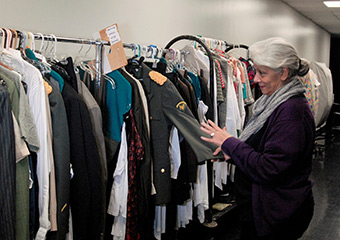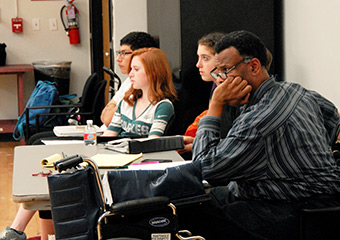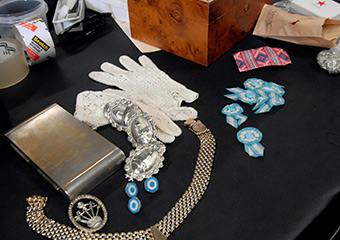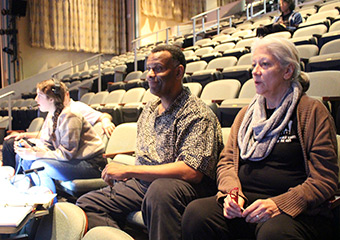Costumes, Passion and Dedication: NWSA Tackles “Evita”

 Costume Designer Estela Vrancovich and Director James Samuel Randolph sat down with Social Miami over a salmon and mushroom risotto lunch on Lincoln Road during a dress rehearsal break of the New World School of the Art’s production of “Evita,” which played at the Colony Theatre, February 19-21.
Costume Designer Estela Vrancovich and Director James Samuel Randolph sat down with Social Miami over a salmon and mushroom risotto lunch on Lincoln Road during a dress rehearsal break of the New World School of the Art’s production of “Evita,” which played at the Colony Theatre, February 19-21.
Vrancovich and Randolph spoke about their commitment, passion and devotion to put on such a complex production filled with costume changes that chronicled the historical events that encompass 18 years of Evita’s life, from her early life all the way to her final moments. Vrancovich, who is Argentine, brought an attention to detail and passion that led her to collect costume pieces at thrift shops in Argentina, which she repurposed to celebrate the glamor of the era. With over 200 costumes, combined with jewelry, undergarments and accessories bringing it close to a 1,000 pieces, the clothes are a character of their own. Their costumes exude timeless beauty so that many could still be worn today.
 Vrancovich walks from actor to actor during the dress rehearsal, readjusting their costumes, playing a mix between a motherly figure and an exacting mentor. As she showed me the dressing rooms at the Colony Theatre, an excited young lady dressed in black motioned to what she was wearing and told Vrancovich: “If I would be an outfit for life, it would be this.”
Vrancovich walks from actor to actor during the dress rehearsal, readjusting their costumes, playing a mix between a motherly figure and an exacting mentor. As she showed me the dressing rooms at the Colony Theatre, an excited young lady dressed in black motioned to what she was wearing and told Vrancovich: “If I would be an outfit for life, it would be this.”
Of equal importance to her was to recreate the glamour of Evita’s dresses while also creating pieces for the poor that displayed their poverty while showing that they still maintained pride in their looks. She used a mix of Argentine, British and American takes on the costume designs and has done a lot of work with many tango dancers in Argentina.
 Randolph used historical research that he shared with his students to help the actors understand their roles and struggles in the time period.
Randolph used historical research that he shared with his students to help the actors understand their roles and struggles in the time period.
SOCIALMIAMI: What lead the NWSA to decide to perform Evita?
VRANCOVICH: For a while I had been telling Dean Patrice Bailey to do “Evita.” I had one “Evita” prior in another theater. I had done it in Argentina with Argentine take and the U.S. with an American take. I was distressed with the American take because of Hollywood or Broadway stereotypical views. I am a tango designer and costume designer on stage. Tango was born in Cuba but has its origins in Africa. Tango developed in Argentina but it belongs to the world. Tango is the same for Argentines, the same thing as Evita is. Evita, at this point, belongs to all Argentines. You don’t have to be Peronista to acknowledge that Evita had an immense amount of influence on the population. Especially on women. She was a fighter. And now, more than any other time, we are understanding the role of women. Women needed to behave a certain way. Now we’re reevaluating the role of women and what women are allowed to do.
SOCIALMIAMI: How does the historical Evita intertwine with the musical?
RANDOLPH: We go through a series of historical events that encapsulate eighteen years of her life, starting when she was about fifteen years old all the way to the final moments of her life. I have done my research. We just see a series things happen to Eva in every scene. We see when it is great, when she is loved and believed to be a saint and when she is absolutely reviled. To some she was like Martin Luther King was in this country. That level of popularity, that level of influence is still felt today.
SOCIALMIAMI: Is this the first time that NWSA has done Evita? How is it a challenging production?
 RANDOLPH: It was done here at the school 21 years ago. The former Dean of Theatre Jorge Guerra, who is a very well-known director in Peru, ran the program here for 15 years. He was the director, and I was his assistant. I also happened to be in the production as one of the generals who gets eliminated by Peron and the Secret Police. We never had the resources of someone like Estela. We had a good designer, but 95% of it was rented. It is one of my favorite shows. It is very challenging show in every aspect. Challenging design-wise, and a huge challenge for the leads because they are singing at high levels of intensity. We have high school students in the show playing the students, which was one of Evita’s main legacies – what she did for children. The idea is that about 75% of NWSA’s student population in some capacity is Latin. We have a wide variety. The actress playing Eva (Melissa Bibliowicz) is Argentine by birth although she was raised here. Her mother is Argentine. My concern is to try to be as accurate as possible.
RANDOLPH: It was done here at the school 21 years ago. The former Dean of Theatre Jorge Guerra, who is a very well-known director in Peru, ran the program here for 15 years. He was the director, and I was his assistant. I also happened to be in the production as one of the generals who gets eliminated by Peron and the Secret Police. We never had the resources of someone like Estela. We had a good designer, but 95% of it was rented. It is one of my favorite shows. It is very challenging show in every aspect. Challenging design-wise, and a huge challenge for the leads because they are singing at high levels of intensity. We have high school students in the show playing the students, which was one of Evita’s main legacies – what she did for children. The idea is that about 75% of NWSA’s student population in some capacity is Latin. We have a wide variety. The actress playing Eva (Melissa Bibliowicz) is Argentine by birth although she was raised here. Her mother is Argentine. My concern is to try to be as accurate as possible.
SOCIALMIAMI: What have been the challenges and rewards of putting the costumes together for “Evita?”
VRANCOVICH: It is has been intense. Twelve-hour days. From the beginning, starting to work at NWSA I was given total freedom. It is beautiful to work like that. The problem is that we have an immense amount of limitations. We don’t have space. The space in itself is the most problematic. It is my fault because I don’t rent. We have a big cast and several changes and many limitations at the school. The shop is tiny. We don’t have a lot of space. We recycle about 90% of the costumes. And everything you see on stage, even the big gown is recycled. I was going to build it from scratch but then I found a gown that could be altered. It fills me with awe that I can go to a thrift shop and find the right thing. And I know exactly what it needs to be. I can tell anyone why that dress is the way it is. And why the person is wearing whatever they are wearing. I guess I was born a costumer. One of my students told me the other day that they are afraid to tell me things because they are afraid to make a fool of themselves because they know that I know why I do what I do. I thought that was beautiful. It is better than a Carbonell! They respect and trust my judgement. It is very hard to gain the trust of the students. They don’t trust just anybody.
SOCIALMIAMI: How did you obtain pieces from Argentina and what prepared you for the role of a costumer, for costumes play such an important role?
VRANCOVICH: I bought about twenty-five pieces in Argentina, and I bought some Evita- inspired jewelry. I found things in that era and made them work. Evita’s designer in Argentina, Paco Jamandreu, was my professor in costuming. I used to go to his house and take classes. He had Evita’s gowns in his living room. The floor was huge, and you walked in there and saw these mannequins with these real Evita gowns. When Evita was big, she would order the gowns from Europe, Dior and all those big names, and he would alter them for her. When she died the General gave Paco a key to a car and said “This is yours.” The car was full with the gowns he had made for her. The General gave them to him as a thank you. Now they are in a museum.”
The New World School of the Arts will host its annual “Rising Stars”, the school’s spectacular performance and visual arts showcase on Thursday, March 17, at various venues. For more information and to purchase tickets, visit http://NWSA.mdc.edu.

Onelia Collazo Mendive is the founder and publisher of GablesCentral.com, a news and culture website covering Coral Gables. She has covered the City of Coral Gables in print and online publications for almost a decade. She has particular interest in the Golden Gate and MacFarlane Homestead Historic District of Coral Gables. Onelia has covered the internet industry since 1999 and has worked as a web editor for various websites. She has covered the arts and cultural scene in Miami since 2007. In addition, she was awarded a National Press Foundation Fellowship for editors and writers program on E-commerce from Vanderbilt University in 1999, and was named a Fellow for the Knight Community Info Challenge Boot Camp in 2012. Onelia co-organizers a monthly Read to Learn Reading Circle and book drive in conjunction with The Children’s Trust, The Miami Book Fair and Books & Books. The Read to Learn Books for Free donates children’s books to 40 bookshelves in Miami including DCF, juvenile hall, and doctors’ offices. She graduated from Florida International University in 1995 with dual degrees with a BA English Literature and a BS in Communications.

